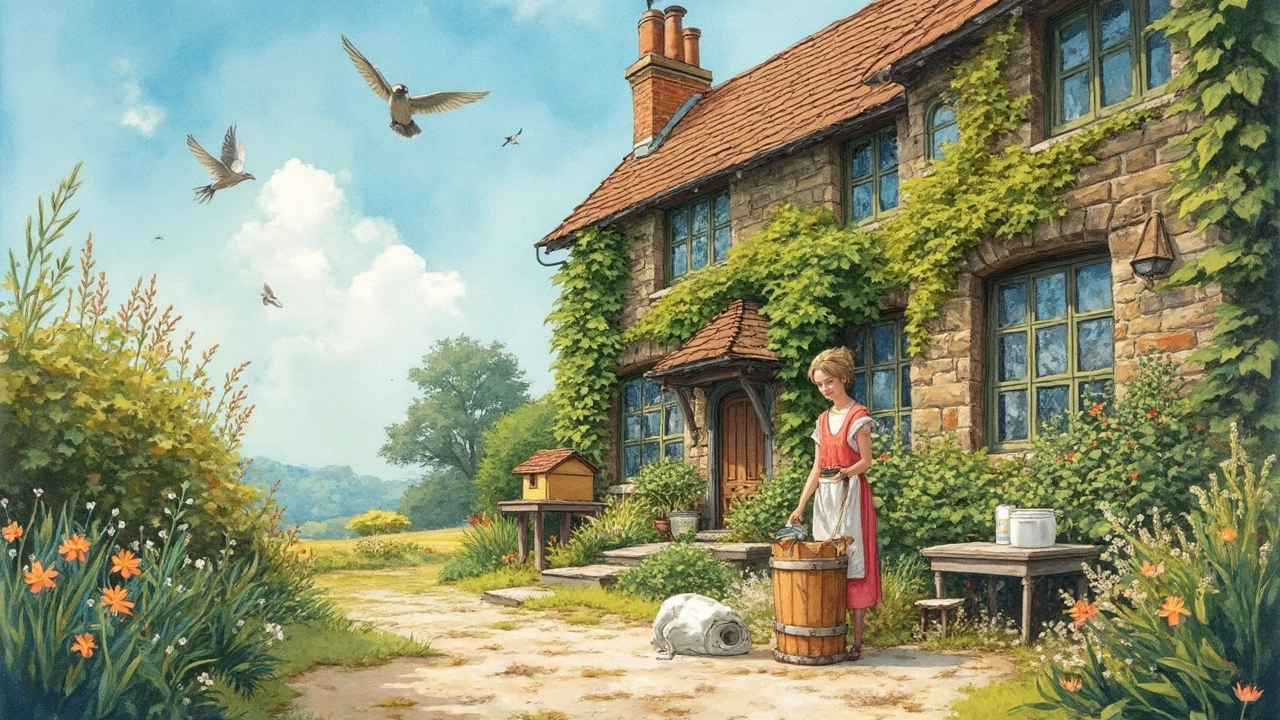So, you're thinking about pressure washing, right? It's super popular and all, blasting away grime in no time. But have you ever thought, 'Is this the best way to clean my patio?' Sometimes, that powerful jet can do more harm than good, especially on delicate surfaces. But don't worry, there are cool alternatives that might just fit the bill better.
Picture this: using an eco-friendly solution that’s gentle yet effective. Doesn’t that sound like a win-win? No harsh spraying, no worries about damage. Just good old-fashioned clean. Plus, they often work wonders without harming the environment. Keep reading to learn smarter ways to deal with dirt and keep your outdoor areas looking top-notch without a pressure washer.
- Understanding Pressure Washing
- Why Seek Alternatives?
- Eco-Friendly Cleaning Solutions
- Gentle Brushing Techniques
- Chemical-Free Deep Cleaning
- Maintaining Surfaces Long-Term
Understanding Pressure Washing
Pressure washing is kind of like using a supercharged garden hose. Imagine a stream of water so powerful, it knocks off years of grime in just a few minutes. Sounds great, right? Well, it usually combines high pressure and sometimes hot water to clean surfaces like driveways, patios, house sidings, and even decks.
The trick is, pressure washers use a motor to create that intense pressure. This force can be adjusted depending on the task. Generally, pressures can range from a gentle 1,300 PSI (pounds per square inch) for cleaning cars and boats to a whopping 4,000 PSI or more for tough jobs like stripping paint from wood.
Here's a quick rundown of the typical parts of a pressure washer:
- Motor: The powerhouse driving the whole thing, either electric or gas-powered.
- Water pump: This is what ups the pressure, moving water with serious force.
- Hose: Specially designed to handle high-pressure water, unlike ordinary hoses.
- Nozzle: This dictates the spray pattern, from a wide fan to a pinpoint stream; some nozzles are color-coded for different tasks.
The whole idea here is to make cleaning a breeze, using water more efficiently. But, here's the catch: too much pressure on the wrong surface can mean trouble. It might strip away layers you didn't want to touch, especially on wood or painted surfaces. Hence, many are looking for pressure washing alternatives that are easier on surfaces yet still effective.
Plus, it's worth noting the environmental aspect. While pressure washing often uses a lot of water, many people are leaning towards more eco-friendly cleaning solutions that save both water and energy. Stay tuned for greener and gentler cleaning options that might just surprise you with their effectiveness without the splashy side effects.
Why Seek Alternatives?
While pressure washing seems like the go-to move for stubborn outdoor stains, it's not always the best choice. Let's break it down. One major issue is the potential to damage surfaces. A strong jet of water can chip off paint, splinter wood, or etch weak spots in concrete. Nobody wants to turn a cleanup into a costly repair job, right?
Another thing to keep in mind: the environmental impact. Yeah, blasting away grime with water gets things done fast. But it also uses tons of water and may send harmful chemicals right into the soil or storm drains. If you're aiming to be more green, finding a gentler, less water-intensive method is definitely worth considering.
There's also the noise factor. Pressure washers aren't known for being peaceful. If your neighbors aren't a fan of early morning cleaning sessions, opting for quieter methods might keep everyone happy.
Sometimes, eco-friendly cleaning solutions or plain old scrubbing can do the trick just as well, without all the downsides. They might take a bit more elbow grease, but they often lead to healthier surfaces and a happier planet. Plus, you might even find that these methods connect you to your space differently—putting a bit of hands-on care into your surroundings feels pretty rewarding.
Eco-Friendly Cleaning Solutions
Alright, let's talk green cleaning. Sure, blasting surfaces with water at high pressure seems easy, but what if we could do it better and kinder to our planet? Enter eco-friendly cleaning solutions. These little wonders use natural ingredients to keep your homes spic and span without the guilt of harming the earth. Plus, they're often just as effective as traditional methods!
One popular method is using a vinegar and water solution. It's simple: mix equal parts vinegar and warm water in a spray bottle, and you’ve got yourself a strong cleaner without the harsh chemicals. Vinegar is great at cutting through grime and also acts as a natural disinfectant. It's a winner for cleaning patios, driveways, and even outdoor furniture.
Another cool option is utilizing baking soda. It's another powerhouse in the home cleaning game. Sprinkle it on the surface you're trying to clean, add a bit of water to form a paste, and scrub away. It’s particularly effective on concrete and brick.
How about some plant-based cleaners? These are commercially available and made from ingredients like citrus oils, which not only clean thoroughly but leave behind a fresh scent. They're perfect for those tough jobs on decks or wood surfaces where gentleness is key.
For those who love numbers, check this out: eco-friendly cleaning products are gaining massive popularity. In fact, a recent survey showed that about 70% of households have tried them in some form. And they’re not going back!
| Method | Main Ingredient |
|---|---|
| Vinegar Solution | Vinegar and Water |
| Baking Soda Paste | Baking Soda |
| Plant-Based Cleaner | Citrus Oils |
Remember, going green doesn't mean losing power or efficiency. Sometimes, it's about working smarter, not harder, with eco-friendly cleaning methods leading the charge. So, next time you're gearing up to clean that deck, think about reaching for one of these alternatives. Your surfaces—and the planet—might just thank you.

Gentle Brushing Techniques
When thinking about cleaning outdoor spaces, pressure washing alternatives like gentle brushing techniques can work wonders, especially for more delicate surfaces like wooden decks or vintage brick patios. You might be wondering why you should bother with a brush when you could just blast the dirt away. But here’s the thing—brushing is way gentler on sensitive surfaces, reducing the risk of unwanted wear and tear.
Let’s start with picking the right tools. A soft-bristled brush is your best friend here. It's perfect for scrubbing without being too harsh. You can find these in most home improvement stores. Pair it with a bucket of warm, soapy water. A mild detergent works well, avoiding those strong chemicals that might damage your surfaces or wreck the environment.
Think of it as a workout: gradual and consistent action will get you the best results without all the burnout. Here's how you can approach it:
- Begin by sweeping the area to remove loose dirt and debris. This makes the scrubbing part way more effective.
- Dip your brush into the soapy water and gently scrub in circular motions. This helps lift the dirt without causing scratches.
- Rinse the area with clean water. You can use a garden hose if you’ve got one around—just make sure it's not on a high setting.
- Let it dry naturally in the sun. The sunlight also has sanitizing properties, believe it or not!
One interesting tip when using brushing techniques—focus on sections at a time. This prevents surfaces from drying with soap on them. And if you want to add a bit of shine, a little vinegar in your rinse water can give surfaces that extra sparkle.
Plus, it’s not just about cleaning. A study even found that doing tasks like these can be therapeutic, easing stress while keeping your home sparkling. With some elbow grease and these techniques, maintaining outdoor surfaces can become a breeze, all while being eco-friendly!
Chemical-Free Deep Cleaning
Want to keep things clean without reaching for chemical-heavy solutions? You’re in the right place. Let’s dive into some simple, no-chemical tricks that can make a huge difference in how you clean your home surfaces.
One of the easiest and most effective ways to start is with a little vinegar and baking soda action. These two are like Batman and Robin in the cleaning world. For instance, mix them into a paste to tackle tough stains on surfaces like concrete or tile. They work wonders without the harsh chemicals that can hurt both the environment and your wallet.
How about using some trusty lemon juice? The acidity in lemons helps cut through grime easily. Plus, it leaves a fresh scent. Just squeeze some juice onto the stain, let it sit for a bit, and then scrub away. It’s a powerful, natural alternative to pressure washing, especially for smaller areas like patios or walkways.
If you're dealing with tougher spots, consider steam cleaning. It uses hot water vapor to break down dirt and grease. The best part? It’s totally chemical-free, and many steam cleaners come with attachments for different surfaces. They're great for wood decks and delicate stones, where pressure washing might be too intense.
Another tip is using good old hot water. Sometimes, heating things up is enough to loosen up dirt. Soak the area in hot water, then scrub with a brush to get it clean without needing any chemicals.
- Mix equal parts vinegar and water for a gentle cleaner.
- Combine baking soda and water into a paste for scrubbing.
- Squeeze fresh lemon juice onto stains and leave it for at least 10 minutes before wiping.
- Try steam cleaning as a high-temperature, no-chemical alternative.
Don't forget about microfiber cloths. They trap dirt and are excellent for dusting without sprays or solvents. Keep a few on hand to clean those stubborn spots after a steam session.
These eco-friendly cleaning solutions are not just about avoiding chemicals—they show you can achieve that deep clean without the heavy artillery of a pressure washer. So, give them a try next time you tackle outdoor cleaning!
Maintaining Surfaces Long-Term
Keeping your outdoor surfaces clean isn't a one-time gig. It's all about setting up a solid routine to ensure your space stays fresh, without always relying on pressure washing alternatives. Sounds daunting? It’s actually pretty straightforward once you get the hang of it.
First off, regular cleaning is key. You don’t need to go all out every weekend, but a consistent schedule is your friend. Pick a mild day and spend a couple of hours brushing away dirt, sweeping leaves, and just checking up on the places you don’t usually give much thought to.
Another tip? Give some love to those little nooks and crannies. We’re talking about the cracks in your pavement or the crevices between your deck boards. These spots can trap moisture, which is a family invitation for mold and mildew. Use a stiff-bristle brush to root out any muck hiding in there.
And when it comes to protecting your surfaces, nothing beats a good sealant. Apply sealant once a year to shield against weather damage and everyday wear and tear. Especially if you live somewhere with harsh winters or brutally hot summers, this step is just plain smart.
Lastly, stay on top of repairs. If you spot chipped stones or cracked bricks, deal with it sooner rather than later. These seemingly small issues can lead to bigger problems if left unchecked. Fixing them right away can save you a ton of hassle and money down the line.
Thinking a bit outside the box can also help. Consider using ground covers or strategic landscaping that naturally reduces dirt and debris buildup, cutting your cleaning time significantly.
All these efforts combined mean less heavy-duty cleaning and more time enjoying your outdoor area. Because at the end of the day, isn’t that the goal?
